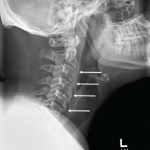Beyond this speculation, an even more fundamental error has been the lack of validation of the investigators’ skill in recognizing periosteal changes.26 The skeletons from the Irene Mound site in Georgia have been the source for many publications. Limiting the analysis of the investigators skills to the tibiae, the results obtained have identified two camps. One group perceived periosteal reaction to be present in 100% of skeletons, while the other group described the complete absence of this finding. My team’s examination achieved an intermediate result. Who is correct? Accuracy can only be claimed with independent verification. Independent verification not only requires selection of the appropriate test, but also that the results be interpreted in light of understanding of disease pathophysiology and/or its transmission through ensuing generations.
This approach can be understood with examination of a phenomenon recognized in Egyptian mummies.30 Standard X-rays suggested calcification of intervertebral discs. The presence of associated black pigmentation suggested that an inherited disease of metabolism, ochronosis, was common among Egyptians. In an effort to independently validate this diagnosis, infrared spectroscopy was used to confirm that the deposition product was homogentisic acid. This compound was noted in half of the Egyptian mummies. When one considers that the transmission pattern of ochronosis is via recessive genes, there is a dilemma. This genetic pattern would predict that no more than one quarter of the population should be afflicted.31 How do we explain this paradox? While routine X-rays suggested generalized disc calcification, CT revealed that the “calcification” was misread and was the result of overlapping shadows caused by multiple calcific nodules. Nuclear magnetic resonance spectroscopy demonstrated that the compound was not homogentisic acid. It identified the embalming material used by ancient Egyptians and that the nodules were salt natrons derived from the same process.
Returning to the validation of the causes of periosteal bone reactions, physical chemistry came to the rescue. After raising bone temperature by three degrees above ambient temperature, the time course of the tissues’ return to the original ambient temperature was assessed.26 It was suspected that the previous recognition of periosteal reaction had been compromised by the inability to distinguish periosteal reaction from a postmortem taphonomic process, bone abrasion, which exposed layers of intracortical bone. Periosteal reaction occurs on top of the original cortical surface, while abrasion exposes the subsurface bone. The time course of heat dissipation differed between abraded bone and that caused byperiosteal reaction, with no overlap in the time course. Taphonomically altered bone revealed a prolonged heat dissipation time compared to bones remodeled by periosteal reaction. Recently, epi-illumination microscopy has been shown to be a useful technique in demonstrating the shaved appearance of abraded bone in contrast to the prominent surface vascular channels seen with periosteal reaction bone remodeling.


